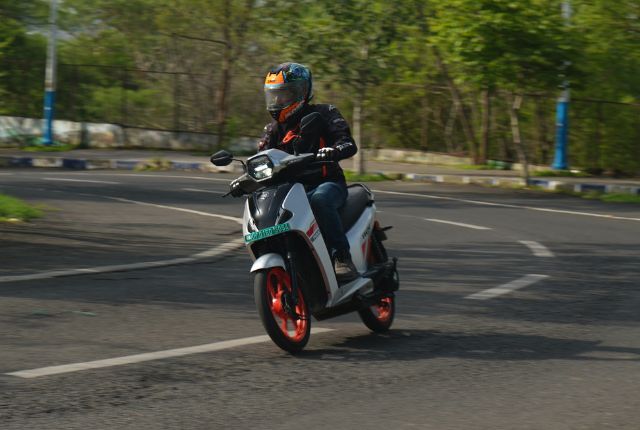
We rode the BGauss RUV350 Max on public roads and some aspects of this electric
scooter surprised us
Story: Anvay Mahajan
Photography: Kalidas M
BGauss introduced the RUV350 last year. During the initial ride that was held during a brief session on a closed, nearly flawless surface, the electric scooter wasn’t pushed to its limits. Now, nearly a year later, we finally had an opportunity to thoroughly test its reliability and rideability.

The first thing that catches one’s eye are the scooter’s striking 16-inch alloy wheels with bold red accents. In video editor terms, the red hue is highly saturated, making it pop visually. The rear wheel is mounted on a single-sided swing-arm. Most of the body is constructed from metal, giving the scooter a solid and sturdy feel. In spite of its kerb weight of 122 kilograms, the scooter feels surprisingly light.

The five-inch TFT display on the RUV350 is clear, bold, and straightforward, with smooth, lag-free operation across various functions. However, the buttons were not up to standard. Notably, buttons like the cruise control and horn got stuck after exposure to rain, which raises questions about reliability in the long run.

The scooter offers three storage compartments: an open front storage equipped with a Type-C USB charging port, a space beneath the floorboard for the 500-W charger, and an under-seat storage area. The RUV350 EX and RUV350i EX, both equipped with a 2.3-kWh battery, provide 20 litres of under-seat storage. In contrast, the RUV350 Max offers a slightly reduced 15 litre space to accommodate its larger three-kWh battery. The 15-litre storage space feels just about sufficient.

The 3.5-kW motor on the BGauss RUV350 Max delivers decent performance for daily urban commuting, making overtakes feel effortless. It offers three riding modes—Eco, Ride, and Sport—with a top speed of 75 km/h. Eco mode is limited to 45 km/h. In Sport mode, we did notice a vibration in the motor as the scooter approached 70 km/h.

The 16-inch alloy wheels offer great confidence while cornering, and the scooter feels nimble and easy to flick through traffic. However, the stiff suspension set-up compromises ride comfort, especially over bumps and rumble strips, thus dampening the comfort advantage typically expected from larger wheels. It’s equipped with drum brakes at both ends, which makes slowing down noticeably a task that requires effort. At this price point, most competitors at least offer a front disc brake, putting the RUV350 at a disadvantage in terms of braking performance.

The three-kWh LFP battery pack on the RUV350 Max comes with an ARAI-certified IDC range of 145 kilometres. We managed to cover 116 km in Eco mode with seven per cent battery still remaining, which is quite respectable. Once the battery level dropped below 10 per cent, the scooter automatically entered “Limp Home” mode, capping the speed at 29 km/h.

The BGauss RUV350 Max is currently priced at Rs 1.40 lakh (ex-showroom). With its 16-inch alloy wheels—a rarity in the electric scooter segment in the Indian market—it certainly stands out visually and functionally. However, when compared to more “traditional” electric scooters such as the Chetak 3501 or the TVS iQube 3.5-kWh series, the limited 15-litre under-seat storage, stiff suspension set-up, and drum brakes feel like a compromise. As a result, the RUV350 Max’s price tag comes across as steep when one considers the quality, features, and practicality offered by its competitors.


Leave a Reply